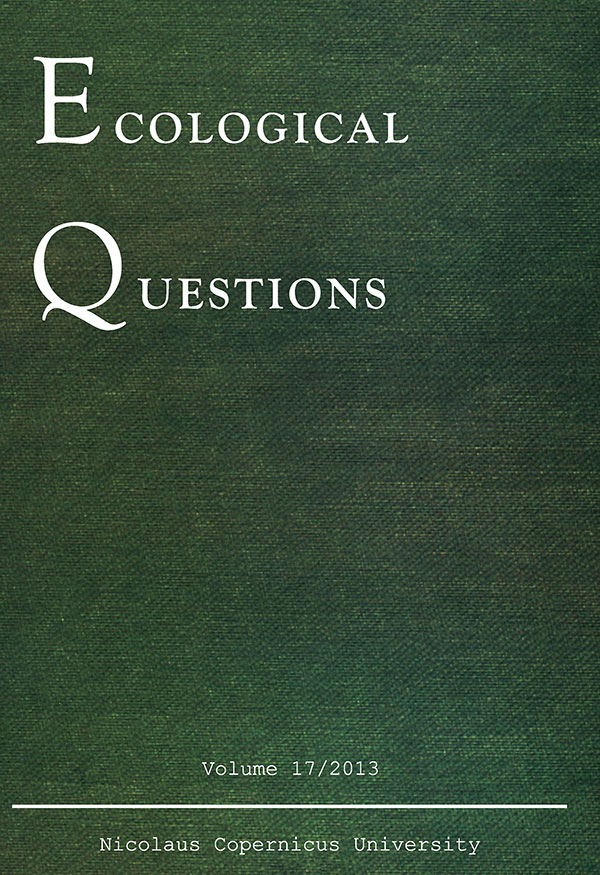The effect of scaling methods on the calculation of environmental indices
DOI:
https://doi.org/10.12775/ecoq-2013-0012Keywords
spatial scaling, remote sensing, GEOBIA, MAUP, generalizationAbstract
Landscape structure quantification is a subject of great interest in the environmental sciences because of the practical advantages it offers, including calculation of the environmental indices useful for land management, ecology and many other fields. A trend of developing new systems of environmental indices can be observed in European Institutions such as EEA and EUROSTAT, but there has been criticism about approaches based on Corine Land Cover (CLC). One of the aims of this article is to review the method of this database preparation for the purpose of calculating environmental indices. This study tests the ability of three methods to scale categorical maps and retaining as much of the original landscape structure information as possible. The vector scaling method is comparable to the preparation of the CLC data. Two other methods use Geo-Object Image Analysis as the main tool for classification. The scaling is performed in this method through building a hierarchy of objects and scaling the raster imagery. The results are compared and evaluated for scale effects and the calculation of environmental indices on the basis of the scaled data. There is no universal method for all the characteristics of the landscape pattern. The GEOBIA-based methods demonstrate greater applicability to fine grained structural and landscape configuration analyses. The vector scaling method is applicable mainly to landscape configuration, its results are also better for visualization of the scaled map.
References
Allen T. F. H. & Starr, T. B., 1982, Hierarchy Perspective for Ecological Complexity, University of Chicago Press, Chicago.
Baatz M. & Schaepe A., 2000, Multiresolution segmentation: an optimization approach for high quality multi-scale image segmentation, [in:] J. Strobl, T. Blaschke (eds.), Angewandte Geographische Informationsverarbeitung, Vol. XII ed., Wichmann, Heidelberg, Germany: 12–23.
Bossard M., Feranec J. & Otahel J., 2000, Technical report N° 40, CORINE land cover technical guide, Addendum 2000, European Environment Agency.
Brown N., Gerard F. & Fuller R., 2002, Mapping of land use classes within the CORINE land cover map of Great Britain, Cartographic Journal 39: 5–14. DOI 10.1179/000870402787288036
Drǎguţ L., Tiede, D. & Levick S. R., 2010, ESP: a tool to estimate scale parameter for multiresolution image segmentation of remotely sensed data, International Journal of Geographical Information Science 24 (6): 859–871.
EBONE, 2011, EBONE European Biodiversity Observation Network, http://www.ebone.wur.nl/UK/ EEA, 2007, Technical report No 17/2007, CLC2006 technical guidelines, EEA (European Environment Agency), OPOCE (Office for Official Publications of the European Communities).
Haralick R. M., 1979, Statistical and Structural Approaches to Texture. Proceedings of the IEEE. 67 (5): 786–804.
Hay G. J. & Castilla G. C., 2006, Object-Based Image Analysis: strengths, weaknesses, opportunities and threats (SWOT), Bridging Remote Sensing and GIS: International Symposium on Object-based Image Analysis. 4–5 July, Salzburg, Center for Geoinformatics, International Archives of the Photogrammetry, Remote Sensing and Spatial Information Science, Com VI, WG VI/4: 5.
Hay G. J., 2002, Multiscale object-specific analysis: An integrated hierarchical approach for landscape ecology. Ph. D. Thesis, Department of Biological Sciences, University of Montreal.
Hay G. J., Dubé P., Bouchard A. & Marceau D. J., 2002, A scale-space primer for exploring and quantifying complex landscapes, Ecological Modelling 153 (1-2): 27–49. DOI 10.1016/S0304-3800(01)00500-2
Heuvelink G. B. M., 1992, An interactive method for multidimensional simulation with nearest neighbor models, Proceedings of the 2nd CODATA Conference on Geomathematics and Geostatistics, Nancy, France: 51–57.
Hunter G. J. & Goodchild M. F., 1997, Modeling the Uncertainty of Slope Gradient and Aspect Estimates in Spatial Databases, Geographical Analysis 29 (1): 35– 49.
Kozioł K., 2012, Znaczenie punktów stałych obiektu w procesie upraszczania [The Importance of fixed points in the simplification proces], Archiwum Fotogrametrii, Kartografii i Teledetekcji 23: 169–177.
Kurczyński Z., 2006, Lotnicze i satelitarne obrazowanie Ziemi [Aerial and satellite Earth imaging], Oficyna Wydawnicza Politechniki Warszawskiej, Warszawa 2006: 388–394.
Levin S. A., 1992, The problem of pattern and scale in ecology, Ecology 73: 1943–1967.
Lindeberg, T., 1994, Scale-space theory: A basic tool for analyzing structures at different scales, Journal of Applied Statistics 21 (2): 225–270. DOI: 10.1080/757582976
Marceau D. J., 1999, The scale issue in the social and natural sciences, Canadian Journal of Remote Sensing 25 (4): 347–356.
Marceau D. J. & Hay G. J., 1999, Remote sensing contributions to the scale issue, Canadian Journal of Remote Sensing 25 (4): 357–366.
Marceau D. J., Howarth P. J. & Gratton D. J., 1994, Remote sensing and the measurement of geographical entities in a forested environment. Part 1: The scale and spatial aggregation problem, Remote Sensing of Environment 49 (2): 93–104.
McGarigal K., Landscape Pattern Metrics, [in:] J. Wiley & Sons, Encyclopedia of Environmetrics, Ltd 2006.
MCPFE, 2011, Forest Europe, Ministerial Conference on the Protection of Forests in Europe, http://www.foresteurope. org/
SEBI, 2012, Streamlining European Biodiversity Indicators, Biodiversity Information System For Europe, http://biodiversity.europa.eu/topics/sebi-indicators/
Solon J., 2004, Ocena różnorodności krajobrazu na podstawie analizy struktury przestrzennej roślinności [Landscape diversity assesment based on landscape structure analysis], Działalność Nauk. 17: 110–112.
Tobler W., 1988, Resolution, Resampling, and All That, [in:] H. Mounsey, R. Tomlinson (eds.), Building Data Bases for Global Science, London, Taylor and Francis: 129–137.
Wang Z. & Müller J. C., 1998, Line Generalization based on Analysis of Shape Characteristics, Cartography and Geographical Information Systems 25 (1): 3–15. DOI: 10.1559/152304098782441750
Wu J., Jelinski D. E., Luck M. & Tueller P. T., 2000, Multiscale analysis of landscape heterogeneity: scale variance and pattern metrics, Geographic information science 6 (1): 1–19. DOI: 10.1080/10824000009480529
Wu J., 2004, Effects of changing scale on landscape pattern analysis: scaling relations, Landscape Ecology, Springer Netherlands: 125–138. DOI 10.1023/B:LAND.0000021711.40074.ae
Downloads
Published
How to Cite
Issue
Section
Stats
Number of views and downloads: 831
Number of citations: 0



